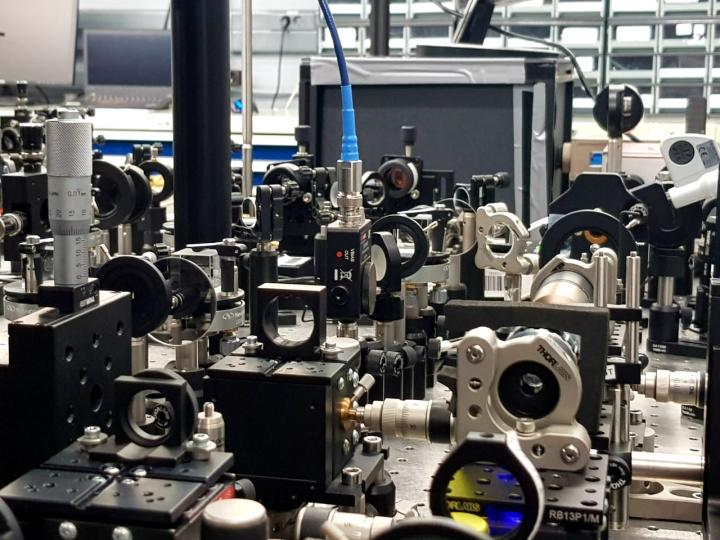
Credit: Skoltech
A team of scientists from the Hybrid Photonics Laboratory at the Skolkovo Institute of Science and Technology (Skoltech) and the University of Sheffield (UK) made a breakthrough in understanding nonlinear physics of the strong interaction of organic molecules with light. Principles of strong light matter interaction open new horizons of ultra-fast and low energy all-optical data processing. The findings were published in Communications Physics and featured in the February issue of Nature Physics. The study was partially supported by Russian Science Foundation (RSF).
Perhaps everybody knows organic matter as the essential building blocks for living nature. Indeed, the interactions between organic molecules and light is a pivotal process for photosynthesis, light-induced biochemical regulation and many other mechanisms in nature making our life on Earth feasible. Beyond that side, there are dozens of applications for a variety of light-matter interactions in organic systems. Nowadays organic materials represent a wide class of materials actively used in light-emitting devices (LED) industry, in flexible electronics and solar cells fabrication, as photosensitive sensors and bio labels of cancer etc.. The rapidly growing organic LED (OLED) market is a good example showing a great commercial potential of organic materials in real-life technologies.
Skoltech’s Hybrid Photonics Laboratory, led by Professor Pavlos Lagoudakis, focuses on developing a new paradigm of optoelectronics based on strong interaction between organic materials and light. The key difference from conventional approaches is that light (photons) in such systems get strongly correlated with collective electronic excitations on a molecule (excitons), which gives rise for new particles, namely polaritons. These light-matter entangled particles inherit ultra-fast propagation of light and electronic properties of materials resulting in a very exotic hybrid form of light and matter called liquid light.
“Does this make a world of difference? Sure it does, as the strong light-matter coupling can slow down photodegradation of molecules extending their lifetime, change the course of photochemical reactions and provide photons with an ability to interact with each other, the latter feature allows us to develop efficient optical signal processing devices”, says prof Pavlos Lagoudakis.
Currently, fiber optic networks handle huge amounts of data but if one wants to process optical signals then light has to be converted into electrical signals and back. In contrast, strong-coupling principles offer unique opportunities for all-optical data processing technologies with record speeds and better energy conversion efficiencies. The past decade has witnessed remarkable achievements in the field of polaritonics, running the gamut from the first organic polariton laser to room-temperature superfluidity and invention of the first organic polariton transistor . It is worth recalling that Skoltech ranks as a global leader of the field.
However, despite remarkable progress in this field, the mechanisms of polariton interactions in organic systems have remained poorly understood fueling debates in the scientific community. The mystery of polariton interactions has finally been resolved: Skoltech’s research gives a decisive answer to this controversial question. The scientists carried out an in-depth experimental study which revealed a clear origin of nonlinear phenomena related to polariton condensates – the state consisting of hundreds and even thousands of polaritons sharing the same properties.
“Our experiments indicate an abrupt shift in spectral properties of polariton condensates when established, that always drives the frequency of polaritons towards higher values. We find it specific for nonlinear processes occurring in the system. As through change of metal colour upon heating one can access the temperature, similarly, we extract nonlinearity of organics by means of in-depth analysis of the frequency shifts”, explains the first author of the paper, Junior Research Scientist at the Hybrid Photonics Labs, Dr Timur Yagafarov.
The comprehensive experimental study accompanied by a thorough data analysis favors unraveling important dependencies of the polariton nonlinear properties on the key parameters of the interaction between organic molecules and light.
The scientists were the first to discover a strong impact of the energy transfer between neighboring molecules on the nonlinear properties of organic polaritons and now understand underlying mechanisms driving polaritons in organics. With the proposed theory, one can find the experimental parameters required to coupling several polariton condensates into a single circuit and building a polariton all-optical signal processor.
From a fundamental point of view, the new knowledge may help to explain the phenomenon of polariton superfluidity in organic matter.
“These findings are of high interest to not only our research area but can be helpful in other fields as well. I believe the nonlinearity mechanisms discovered are quite general among the organic materials, therefore it might prove to be universal for strongly-coupled organic systems”, comments Senior Research Scientist at the Hybrid Photonics Laboratory, Dr Anton Zasedatelev.
###
Media Contact
Alina Chernova
[email protected]
7-905-565-3633
Related Journal Article
http://dx.




